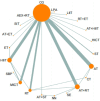Effects of exercise on body fat percentage and cardiorespiratory fitness in sedentary adults: a systematic review and network meta-analysis
- PMID: 40746688
- PMCID: PMC12310449
- DOI: 10.3389/fpubh.2025.1624562
Effects of exercise on body fat percentage and cardiorespiratory fitness in sedentary adults: a systematic review and network meta-analysis
Abstract
Background: Sedentary behavior is increasingly prevalent worldwide and associated with numerous health concerns including obesity and cardiovascular diseases. This study aimed to evaluate the comparative effectiveness of various exercise interventions on body fat percentage and cardiorespiratory fitness in sedentary adults.
Methods: A systematic review and network meta-analysis of randomized controlled trials was conducted. Comprehensive searches were performed in PubMed, Embase, Web of Science, and Cochrane Library databases through December 10, 2024. All retrieved literature was imported into EndNote 21 for duplicate removal, and two reviewers independently screened articles and extracted data. Study quality was assessed using the ROB2 tool. Primary outcomes included body fat percentage (BF%), maximal oxygen uptake (VO₂max), and peak oxygen uptake (VO₂peak). Network meta-analysis used random-effects models with SUCRA ranking and low to moderate heterogeneity (I2 = 28-41%). Publication bias was assessed using funnel plots.
Results: Fifty-one randomized controlled trials involving 2,201 participants were included. Risk of bias assessment showed 27 studies (52.9%) with low risk, 21 studies (41.2%) with some concerns, and 3 studies (5.9%) with high risk. Funnel plots indicated minimal publication bias. For BF% reduction, aerobic training ranked highest (SUCRA 97.5%), followed by resistance training combined with endurance training (SUCRA:78.2%) and aerobic training combined with strength training (SUCRA:77.4%). For VO₂max, strength training showed superior effectiveness (SUCRA:95.9%). For VO₂peak, aerobic training ranked highest (SUCRA:70.0%).
Conclusion: This network meta-analysis demonstrates that aerobic training is most effective for reducing BF%, while strength training shows superior effectiveness for improving VO₂max in sedentary adults. Aerobic training also shows promise for enhancing VO₂peak. These findings provide evidence-based guidance for exercise prescription in sedentary populations, suggesting that different exercise modalities should be selected based on specific health improvement goals.
Systematic review registration: PROSPERO (https://www.crd.york.ac.uk/prospero/display_record.php?RecordID=637089), identifier (CRD42025637089).
Keywords: body fat percentage; exercise intervention; maximum oxygen uptake; network meta-analysis; peak oxygen uptake; sedentary behavior.
Copyright © 2025 Huang, Feng, Xie, Wang, Wang and Wang.
Conflict of interest statement
The authors declare that the research was conducted in the absence of any commercial or financial relationships that could be construed as a potential conflict of interest.
Figures







Similar articles
-
Interventions for promoting habitual exercise in people living with and beyond cancer.Cochrane Database Syst Rev. 2018 Sep 19;9(9):CD010192. doi: 10.1002/14651858.CD010192.pub3. Cochrane Database Syst Rev. 2018. PMID: 30229557 Free PMC article.
-
Systemic pharmacological treatments for chronic plaque psoriasis: a network meta-analysis.Cochrane Database Syst Rev. 2021 Apr 19;4(4):CD011535. doi: 10.1002/14651858.CD011535.pub4. Cochrane Database Syst Rev. 2021. Update in: Cochrane Database Syst Rev. 2022 May 23;5:CD011535. doi: 10.1002/14651858.CD011535.pub5. PMID: 33871055 Free PMC article. Updated.
-
Systemic pharmacological treatments for chronic plaque psoriasis: a network meta-analysis.Cochrane Database Syst Rev. 2017 Dec 22;12(12):CD011535. doi: 10.1002/14651858.CD011535.pub2. Cochrane Database Syst Rev. 2017. Update in: Cochrane Database Syst Rev. 2020 Jan 9;1:CD011535. doi: 10.1002/14651858.CD011535.pub3. PMID: 29271481 Free PMC article. Updated.
-
Interventions for promoting habitual exercise in people living with and beyond cancer.Cochrane Database Syst Rev. 2013 Sep 24;(9):CD010192. doi: 10.1002/14651858.CD010192.pub2. Cochrane Database Syst Rev. 2013. Update in: Cochrane Database Syst Rev. 2018 Sep 19;9:CD010192. doi: 10.1002/14651858.CD010192.pub3. PMID: 24065550 Updated.
-
Systemic pharmacological treatments for chronic plaque psoriasis: a network meta-analysis.Cochrane Database Syst Rev. 2020 Jan 9;1(1):CD011535. doi: 10.1002/14651858.CD011535.pub3. Cochrane Database Syst Rev. 2020. Update in: Cochrane Database Syst Rev. 2021 Apr 19;4:CD011535. doi: 10.1002/14651858.CD011535.pub4. PMID: 31917873 Free PMC article. Updated.
References
Publication types
MeSH terms
LinkOut - more resources
Full Text Sources
Medical
Miscellaneous

